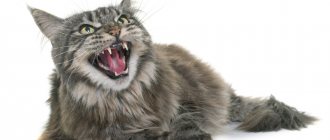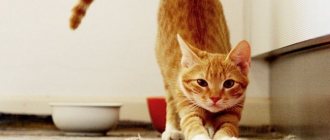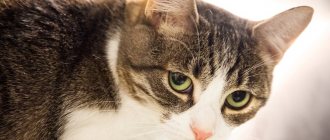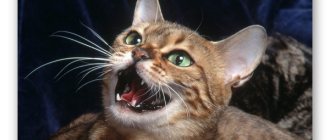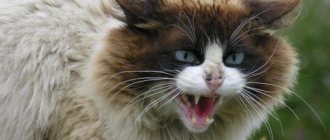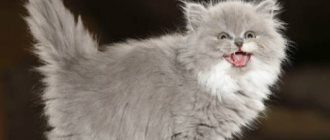Catnip is a plant (herb) that also has other names - catmint and catnip.
- What is catnip
- What Attracts Cats to Catnip
- Why do cats and cats need catnip?
- When not to use catnip
- Catnip cost
Even in Egypt, catnip was given to “revered” cats living in the temple of the goddess Bast; these animals were highly revered. In Celtic regions, people valued the herb for its healing properties, and in China, catnip was recognized as an energizing mood booster. This grass was often used as bait for ordinary or even “big” cats (leopards, panthers).
What is catnip - photo and description
Catnip (lat. Népeta catária) is a low perennial herbaceous plant with heart-shaped leaves and small light lilac flowers collected in a tassel.
There are more than 200 subspecies of catnip.
The height of some plants reaches about 100 cm, while others are less than half a meter. The appearance of the stem is uneven, the flowers look like small bouquets, seem to be collected together, have a white and pinkish color with brown spots, and sometimes purple.
Some flowers have wavy edges. And the leaves look like someone cut them in the shape of a heart.
The aroma of catnip is simply amazing: geranium, rose and lemon combined together.
Where does catnip grow?
Catnip can be found in literally all regions from the European part to the Far East; the grass sprouts in forests, fields and garden plots.
Countries where catnip (catnip) is found: Europe, Africa, America.
Currently, catnip grows almost all over the earth, since the plant is resistant to different climates.
Why does a cat lie on a person and purr? Why or why do cats purr?
We believe that cats make this velvety sound when they experience pleasant emotions... This is true, but only partly.
It turns out that an animal can purr for many reasons, and not only when it feels good. That's what we thought!
A way to calm down
In stressful situations, cats begin to purr.
This happens due to the fact that in childhood, when the mother was nearby, she would certainly purr songs to the kittens and thereby calm the tailed baby. In this way, small, adult and old cats try to calm themselves down in difficult life situations. Have you noticed that these sounds appear at the most inopportune moment? For example, during unloved combing or, in general, at that moment when the cat is angry and bites! It turns out he does this in order to pull himself together. The sounds produced have a calming effect on them.
Advice!
Next time you pet your pet, think about it! Or maybe at this moment he doesn’t like your stroking at all?
But our pets do not always purr when they are in a bad mood. When you come home and the cat greets you with a purr and a joyful “purr”, affectionately rubbing itself and walking with its tail, it means that it is glad to see you. Often, along with purring, cats like to hug and poke their noses in our faces. This is how they show us their love (by the way, sometimes animals can make half-meow, half-murmur sounds). Well, isn't it nice?
Sound therapy
It turns out that the sound of purring is pleasant not only for humans! By using their vibration, kittens are able to recover faster and also help us in this. The low timbre of this sound improves metabolic processes, promotes the healing of wounds and abrasions, and reduces pain. It’s not for nothing that they say that a cat lies down on a sore spot to heal it! So take your furbaby and get some relaxing sound therapy!
Charger
Cats get a lot of rest (which is why it is so important to provide a decent home for them). Of course, they also like to be awake, but they spend more time sleeping. It is believed that “purring” is a kind of exercise to keep their muscles and bones in good shape.
It is believed that “purring” is a kind of exercise to keep their muscles and bones in good shape.
Important! Vibration prevents muscles and joints from atrophying from prolonged inactivity
A way to demand something or an appeal
Also, by purring, cats are able to ask for something or even demand it! A cat may lie down next to you and start purring not at all from pleasure.
Thus, she attracts attention and asks the person for a little affection. Give your pet a little love and the volume of sounds emanating from it will increase significantly
Why does a cat trample and move its paws and purr loudly when you stroke them?
And sometimes they can climb on you and lie on your stomach. So why do they do this? When your furry pet climbs on you, this is the highest point of trust and one of the ways of greeting. But in theory, fingering with their paws should disappear over time, because this is the behavior of kittens in the first place - thus, they “milked” their mother in childhood. Most often, cats are taken away from their mother too early and they do not have time to grow up. Again, this behavior is a demonstration of joy and trust in you.
What Attracts Cats to Catnip
By nature, cats are very sensitive to essential oil. Cats are attracted to catnip by its floral-lemon smell, and after they smell it, a whole show begins: within 10 minutes, the animals go into a frenzy, licking and biting the plant, purring loudly and shaking their heads, and this effect extends even to wild cats. In the past, catnip was used as bait for lynxes, pumas, leopards and even lions.
But when the pet tastes the plant, no stimulating effect occurs; on the contrary, our pet friend calms down. You don’t have to worry, nothing bad will happen, because according to research, catnip does not cause deterioration in a cat’s health due to its narcotic composition. Interestingly, cats have intuition. Animals know when to stop sniffing or chewing the mint.
What's happening? Why do cats and cats have such a strange condition? Essential oils (they contain nepetalactone, which causes a cat to experience slight hallucinations when it enters the animal's nostrils) bind to receptor proteins that stimulate each sensory neuron. The olfactory bulb (its neurons) influences certain areas of the cat's brain, which regulates every emotional reaction. What causes an excitatory reaction to an irritating smell. Information comes from the amygdala and is transmitted to the area that shapes the cat’s behavior in various situations.
The autonomic nervous system generates a neuroendocrine response in the lower part of the brain (pituitary gland) and the condition in cats becomes similar to what happens during estrus.
Therefore, some conclude that mint is an artificial pheromone producer in cats. The presence of susceptibility in cats is hereditary. Many cats are not attracted to this grass at all, and small kittens are indifferent to it until they reach puberty.
Zoologists have determined that the smell of catnip (catnip) during the period of puberty of cats (lions, lynxes, etc. animals) is comparable to the secretions of a female individual ready for mating. Catnip essential oil contains nepetalactone, which has a stimulating effect on a third of sexually mature males.
What happens during a veterinary examination?
The veterinarian will start with a physical examination and palpation (palpation), and sometimes this is enough. If there are any questions about the presence of foreign objects, you will be advised to undergo additional examination: an x-ray or a blood test.
If complications develop or there is concern that the cat is unlikely to cope on its own, the veterinarian may need to perform an endoscopy, which is a non-surgical procedure to examine the digestive tract (under anesthesia), or surgery. During endoscopy, a foreign body is examined in real time and future tactics are determined. Typically this happens before surgery.
Recovery from endoscopy is usually fairly quick. The cat will most likely go home the same day. But sometimes she is left under observation overnight.
What is catnip for and why do cats need it?
What are the benefits of using catnip. It is often believed that the cat plant serves as a behavior correction for some cats. For example, in highly aggressive pets, after they eat catnip, their behavior becomes docile and calm, while slow and lethargic cats can become active and playful.
Catnip mint (dry catnip) photo
It has also been established that the use of this herb has a bactericidal effect, that is, it relieves stomach spasms.
Veterinarians testify that catnip is a suitable remedy for stressful situations for animals. They can easily withstand travel and trips to the veterinary clinic. Also, this herb does not act as a strong drug; the cat will not get used to it if you watch your pet and do not let it near catnip often.
After catnip became popular among cats, many experts began to produce special toys for cats with the smell of catnip.
Some owners make their own artificial mouse from rags and add dried cat grass inside.
Many homes use drops (mint spray) that are placed on special devices for cats where they scratch their claws. Thus, cats do not spoil good furniture and fabrics, but get used to the fragrant scratching post.
If your cat doesn't have an appetite, you can add some dried or fresh catnip leaves to the food. It is important to note that catnip is considered an anthelmintic.
If this healing herb is not available in nature, you can plant it in a pot and place it on a windowsill where the sun's rays constantly fall. Watering frequently is not recommended; the soil should be non-acidic. To prevent your pet from eating all of the catnip at once, after ripening the plant should be picked, crushed and dried. It is better to keep it away from cats and cats in a place inaccessible to them.
In addition to the fact that cats love this grass, it is also rich in nectar, so bees are also partial to it. It is also added to vermouth, shampoo, and perfume.
Raw catnip photo
Catnip mint is used as a spice in confectionery, in soap making, and for cosmetic purposes. They found that the herb has a healing effect on many diseases: it improves the gastrointestinal tract, soothes migraines, and eliminates cough. Catnip also improves blood circulation, can cleanse the lungs, and overcome insomnia.
External preparations are made from catnip to treat boils, tumors and are used in case of skin inflammation. In such cases, herbal preparations act as an antibiotic.
And catnip can also help protect against mosquitoes.
When should you not use catnip?
If your cat is pregnant, you should protect her from stressful situations and not overstimulate her with catnip. There are also cats that react too violently to this plant, because the nervous system is exhausted due to frequent emotional outbursts. In general, nature prescribes in them which plant is required in specific cases and in what quantities.
How to stop a cat from biting its feet?
- The fact that your cat is after your feet is not due to aggression in most cases. It is simply a form of hunting fun and game that you have become the object of for some reason.
- The legs move and are "at the level" of the cat, which can easily grab them - that's why it attacks them and runs away.
- The cat does not understand that this surprises you - he does not think in these categories, he simply fulfills his need.
- Do you want him to stop attacking your feet and biting your fingers? Then you should let him hunt for other "right" objects - in short, play with him more. You can do it a little, but several times a day - in this way the purring pet will discharge the accumulated energy and satisfy its natural instincts. This will greatly increase the chances that he will leave your legs alone.
- If you have a kitten at home, teach it from the very beginning that your feet and hands should not be bitten. This will pay off in the future - cats who were not allowed to play biting when they were young are less likely to "attack" their owners as adults.
- If your purr is the only cat in the house, then adding another furry friend might also be a good idea. Two cats usually play and hunt with each other - which, of course, does not mean that you can spend less time with them. In any case, there is no escape from a cat fishing rod or a plush mouse.
Everyday Reasons for Frequent Yawning
Cats, like humans and other animals, behave in a similar way and begin to yawn under certain conditions:
- Stuffiness in the room. Increased humidity, temperature and lack of oxygen cause yawning to provide additional air.
- Confusion of the animal. In this state, a good yawn helps you quickly make a decision for further action. Again, this is due to the increase in oxygen concentration in the animal's blood and brain.
- Boredom. Against the background of this state, drowsiness increases, and yawning becomes the expected result of a lack of entertainment.
- The period after eating. For complete digestion, the body redistributes blood, resulting in most of it accumulating in the digestive system. Blood circulation in the brain decreases. Yawning helps compensate for oxygen deficiency.
- Physical fatigue. Yawning in this case means going to bed soon. A long rest will compensate for the loss of strength in the future, and the pet will wake up cheerful and active.
As you can see, yawning is not something inexplicable. All physiological processes in the body have a clear sequence and mechanisms to compensate for the listed conditions.
Owner's actions. In order for the pet to feel good, the owner must follow the recommendations of specialists:
- First of all, you need to let your cat sleep as much as she wants. You cannot intentionally wake a cat, even if it keeps you awake at night. There are more humane ways to solve this problem.
- During the daytime, you should pay more attention to your pet and play active games with it. This will not only allow the animal to release all excess energy, but will also strengthen the bond with the owner.
Whatever the innate instincts and habits of the mustachioed tabby, exercise during the day will ensure healthy and sound sleep at night.


